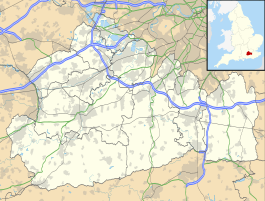Hampton Court station
| Hampton Court |
|
|---|---|
 |
|
|
Location of Hampton Court in Surrey
|
|
| Location | East Molesey |
| Local authority | Borough of Elmbridge |
| Managed by | South Western Railway |
| Station code | HMC |
| DfT category | C2 |
| Number of platforms | 2 |
| Fare zone | 6 |
| National Rail annual entry and exit | |
| 2011–12 |
|
| 2012–13 |
|
| 2013–14 |
|
| 2014–15 |
|
| 2015–16 |
|
| Key dates | |
| 1 February 1849 | Opened |
| Other information | |
| Lists of stations | |
| External links | |
| WGS84 | 51°24′10″N 0°20′33″W / 51.4028°N 0.3425°WCoordinates: 51°24′10″N 0°20′33″W / 51.4028°N 0.3425°W |
|
|
|
Hampton Court railway station is a suburban terminus railway station in East Molesey in Surrey a few metres short of Hampton Court Bridge the midpoint of which is a boundary of Greater London. Across the river the station serves Hampton Court Palace and its adjoining park-side houses, riverside homes, hotels and boutiques in the London Borough of Richmond upon Thames, and is in Transport for London's Travelcard Zone 6; the station is across the River Thames from Hampton Court Park, Gardens and Bushy Park.
The station is the terminus of the 1.5-mile (2.4 km) Hampton Court Branch Line that has one junction — with the South Western Main Line (west of Surbiton). One through station is on the branch, Thames Ditton. The station was built on the island formed between the river Mole and its close distributary, the Ember. Access was first via a wooden bridge from Creek Road. The branch was opened on 1 February 1849. In its first two years the carriages were pulled by horses. Regular steam locomotives replaced the horses in the year 1849-1950 tender-first when proceeding down the line (rather than "up" to London), while construction of the first turntable was underway. By 1868 four lines, four platforms, a railway turntable, a coal depot and ancillary buildings comprised a greater version of the site. The peak capacity of this station was between 1912 and 1929 when over 10 tracks fanned out at the site; four sets of tracks were designated for shuffle sidings (to augment services to the rest of the network); four were dedicated for the station itself and two lines were goods sidings for goods including bulk materials and the coal depot. During this period a Thames side turntable was removed (the foundations of which were revealed on proposed redevelopment by Gladedale in 2013). It is believed the turntable was re-established adjacent to Summer Road and Hampton Court Way.
...
Wikipedia

